21.3.2012 | 14:15
Reykjavík - monthly means as originally published
Measurements in the modern style started in Reykjavík in May 1880. There are earlier observations available but made with unsheltered wall instruments. These can be added to the series back to 1866 and observations were also made in Reykjavík during 1820 to 1854. We will hopefully look at these early measurements later.
The history of the Reykjavík station is quite complicated. The Reykjavík station was operated by the Danish Met. Institute (DMI) from 1880 to 1910 and monthly mean temperatures were published in the yearbooks of the Institute (Meteorologisk Aarbog) which are available online (see an earlier post). During this period there were a few observers and the station was relocated within the town three or four times. A wall-mounted instrument screen was used during the first part of the early period but it was later replaced by a free standing one - the first one in Iceland.
The thermal characteristics of the early screens are better known than elsewhere in Iceland at this time as it was for a considerable period equipped with a thermograph which was read every hour. So we know the diurnal cycle quite well. It conforms well with later-time diurnal cycle observations. A few months of thermograph sheets are missing.
The main thermometer was read three times per day at fixed hours. The DMI always used the average of these + a separate fixed constant for each month (to account for the seasonal variation of the diurnal range). In comparison with modern methods these early calculations tend to have a daytime bias - resulting in slightly elevated temperatures. This is one of the main reasons for the adjustments that have been used later on the means. We will look at this problem later.
The climatic station in Reykjavík stopped making observations in December 1910, temperature measurements continued at a telegraph station in the town but data from this station were never published - and are not used in the attached dataset, except during 1920 and 1921 - which were published.
When the station in Reykjavík was discontinued in 1910 a new one was established just out of town at the newly built Vífilsstađir sanitarium. This location is slightly warmer in summer but colder in winter than the downtown stations. The published monthly means from this station are included in the attached dataset.
During the early period from 1880 to 1920 a few months are missing from the DMI publication. The Icelandic Meteorological Office (IMO) was established in 1920 and took over the DMI station net. Proper observations began again in Reykjavík (in a wall screen) in May 1920. Observations were made at fixed hours. In 1924 a thermograph was introduced again at the station and during 1924 to 1948 all the published temperature means in Reykjavík were calculated as the average of thermograph readings every two hours. There were daily comparisons of the thermograph and the fixed hour observations.
Since 1949 the Reykjavík monthly mean is calculated as the average of observations made every three hours.
The DMI also published the average monthly minimum temperature during the first few years. A minimum thermometer was, however, in use in Reykjavík during most of the early period, but the means were not published. The minimum thermometer was used for the calibration of the thermograph mentioned above during most of the 1884 to 1907 period.
The IMO has published monthly means of maximum and minimum thermometer readings since 1920. These means are included in the attached dataset.
The figure shows the annual mean temperature in Reykjavík 1881 to 2011 (as published). No external adjustments have been used.
Relocations are marked with vertical lines. In late 1931 the station was relocated to a rooftop in the town centre and remained there until the end of 1945. The data (above and in the attachment) have not been adjusted for this change nor others. Later versions of the dataset (e.g. the one available at the IMO website) do include adjustments for the relocations. All adjustments are subject to revisions at a later date.
Some internal adjustments are needed during the early part of the series due to later changes in calculation methods. The fixed-hour means that form the basis of both the DMI average method and recent adjustments by the IMO will be made available at this website later.
The data in the attachment are semicolon delimited with a period as decimal seperator.
Um bloggiđ
Iceland Weather blog
Nýjustu fćrslur
- Unusually high temperatures
- Unusually high sea level pressure
- Sea level pressure: Unusually low in Iceland this winter
- A new national maximum temperature record for December
- A new sea level pressure record for June in Iceland
- An unusually warm April in Iceland
- A new October high pressure record in Iceland
- A new absolute September maximum temperature record in Iceland
Heimsóknir
Flettingar
- Í dag (11.7.): 0
- Sl. sólarhring:
- Sl. viku: 3
- Frá upphafi: 0
Annađ
- Innlit í dag: 0
- Innlit sl. viku: 3
- Gestir í dag: 0
- IP-tölur í dag: 0
Uppfćrt á 3 mín. fresti.
Skýringar
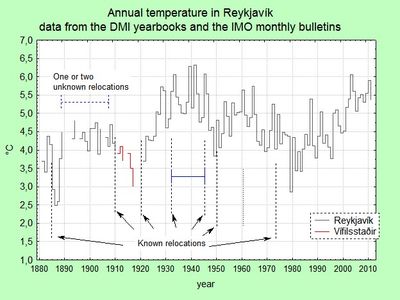
 Reykjavík unadjusted temperature
Reykjavík unadjusted temperature
 hoskibui
hoskibui
 svatli
svatli
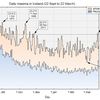
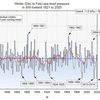
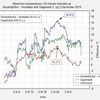
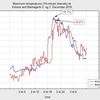
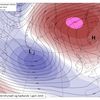
Bćta viđ athugasemd [Innskráning]
Ekki er lengur hćgt ađ skrifa athugasemdir viđ fćrsluna, ţar sem tímamörk á athugasemdir eru liđin.